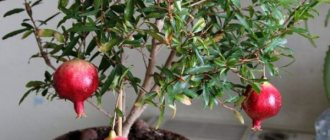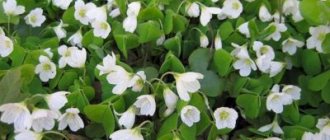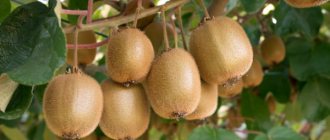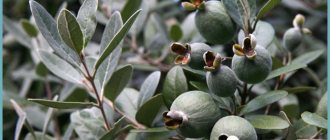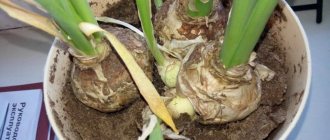The pomegranate tree (Punica), or as it is also called pomegranate, is not represented by very large shrubs and trees, but this genus belongs to the Derbennikov family, although more recently it was called the Pomegranate family. The Latin name of the genus comes from the word Punic or Carthaginian, since this plant is widespread in the territory of modern Tunisia (very long ago it was called Carthage). The origin of the Russian name for such a plant is associated with the Latin word “granatus”, translated as “grainy”. In the ancient world, the pomegranate was called the “grain apple”, while in the Middle Ages it began to be called the “seed apple”. It is interesting that even today in Italy they believe that it was the pomegranate that Eve was tempted in paradise. Today, such a plant can be found in nature in Western Asia and Southern Europe. Gardeners and flower growers cultivate only 1 species of this genus, namely, the common pomegranate. The fruits of this plant are very healthy and have an excellent taste, which is why pomegranate is widespread in cultivation, and it is grown both in open ground and indoors. However, it can be grown using the seed of the fruit, which scientists call pomegranate.
Brief description of cultivation
- Bloom . After planting, the plant blooms only after 3 years.
- Lighting . The light should be bright, but always diffused.
- Temperature regime . During intensive growth of the tree - from 18 to 25 degrees, and during the dormant period - from 12 to 15 degrees.
- Watering . During the period of active growth, watering should be frequent and abundant, but during the flowering period, watering should be reduced. In winter, the bush should be watered sparingly.
- Air humidity . Experts advise on hot days in the evening to moisten the foliage with lukewarm water from a sprayer.
- Fertilizer . In the spring-summer period, fertilizing is carried out once every 2 weeks and a mineral complex fertilizer for house plants with a low nitrogen content is used. In winter, all feeding is stopped.
- Rest period . It begins in late autumn and ends in February. When the bush needs rest, its leaves begin to fly away.
- Transplant . Young trees need regular replanting, which is carried out once a year. Bushes older than three years should be replanted only if necessary, after the roots no longer fit into the container.
- Trimming . The bush is pruned in February to form the crown and stimulate branching.
- Reproduction . By seed method, cuttings and grafting.
- Harmful insects . Mealybugs, spider mites, scale insects, aphids, codling moths and whiteflies can settle on the bush.
- Diseases . Branch cancer, root rot.
Features of pomegranate
Pomegranate is a long-lived deciduous tree. In nature, it grows in the subtropics and has a height of about 5–6 meters. However, at home, such a tree does not grow higher than 200 cm. The branches are thin and prickly. The greenish shiny leaf plates are oval in shape and about 30 mm long. Pomegranate blooms in the last weeks of spring, and flowering continues throughout the summer. The flowers are orange-red in color, and they come in 2 types: there are a large number of sterile bell-shaped flowers, and there are also bisexual pitcher-shaped flowers that set fruit. The pomegranate produces a spherical fruit, which is essentially a large berry with a leathery pericarp; it reaches about 18 centimeters in diameter. The color of the peel can be brown-red, orange-yellow, or some other shade in between. The fruit is divided into 6–12 nests or chambers, which are placed in 2 tiers; they contain up to 1200 seeds, sometimes more. All seeds are surrounded by a succulent cover. The first fruiting is observed at the age of three. The tree bears fruit for 7–40 years. Today, Homemade Pomegranate is very popular among gardeners, for example, as: coffee tree, mango, indoor lemon, orange, date palm and other exotic plants that cannot be grown in open ground in mid-latitudes. However, before planting a pomegranate, you should consider that all the efforts and years of waiting may be in vain.
Such a tree can be grown indoors from a seed, but this can only be done if optimal conditions are created for it, as well as if it is properly cared for.
How to grow indoor pomegranate. Website "Garden World"
Seed selection
Seeds can also be taken from purchased fruit. However, even if there is a harvest (which does not always happen), its taste will be much worse, since hybrids are sold in markets and stores.
Only ripened seeds are used for planting. They are quite hard and have a creamy tint. Green or soft ones are not used for planting. Before planting, the grains must be completely cleared of pulp, then washed and dried well. They should not be wet.
Planting pomegranate seeds
Important! The pomegranate germinates quickly enough, but not too quickly. Experts recommend soaking the grains in a solution of Humate or Zircon for a day before sowing. This will help them germinate at the same time.
Growing pomegranate from seed
Seed selection
Fresh pomegranate seeds are quite suitable as seeds, which must be taken from a ripe, beautiful and completely healthy fruit. Remember that pomegranates bought at the market or in a store are hybrids; therefore, a tree grown from such a seed is not able to retain the taste qualities of the mother plant, but it can have a very high decorative value. The best option would be to find a tasty and fully ripened pomegranate obtained from a houseplant. All remaining pulp must be removed from the seeds removed from the fruit. Seeds suitable for sowing should be creamy in color and feel very firm to the touch. Pale green and soft seeds should not be sown. The seeds must be kept for half a day in water mixed with 2-3 drops of Epin or Zircon, this is necessary to stimulate germination. Make sure that the seeds are not completely immersed in the solution, as they need both moisture and oxygen.
Sowing rules
To grow such a tree, you will need a loose soil mixture, which includes peat, nutrient soil and sand. To do this, you can buy a universal substrate for flowering plants in a specialized store; the fact is that such a plant is undemanding in terms of the composition of the soil mixture. When the seeds are prepared, they need to be dried, after which they are planted in the substrate to a depth of 10 to 15 mm. The crops need to be watered with a small amount of water, then the container is covered with glass or film on top and put in a sunny place.
In order for the seedlings to appear in just half a month, sowing should be done in the last winter or first spring weeks. If sowing is done at a different time, then seedlings may appear only after several months.
Dwarf pomegranate from seeds
Caring for pomegranate seedlings
In order for growing such a tree indoors to be successful, optimal conditions must be created for it. It feels comfortable when the room temperature is about 25 degrees, the room must be systematically ventilated, and the soil mixture must be moistened in a timely manner with lukewarm water from a sprayer. After the seedlings grow their first true leaf blades, they must be planted, and the root must be shortened by 1/3. They are planted in individual small pots, which are filled with fertile substrate, and do not forget to make a good drainage layer at the bottom. The bush should be placed on a well-lit windowsill; the fact is that it should receive direct sunlight for at least 2 hours a day. If seedlings appeared in winter, they will need additional lighting. When the plants have 2 pairs of true leaf blades, they will need pinching, which is necessary to stimulate the growth of the bush with two crowns. After all the stems grow 3 pairs of leaf blades, they will also need pinching. Thanks to this, the bush will be thick and spectacular. The temperature in the room where the young tree grows should be about 20 degrees, and it should be systematically ventilated. In the warm season, it is recommended to move such a plant outside (to a terrace or balcony), where it will feel comfortable, since it needs a large amount of sunlight and fresh air.
10 months after the seedling appears, the first flowering may begin. In autumn, all the foliage will fly off the pomegranate, and it will begin a dormant period. Of course, you can make it grow actively in winter, but this will lead to rapid depletion of the plant. In this regard, he must be given a rest. The bush should be moved to a cool place (from 10 to 12 degrees), watering should be reduced, and feeding should also be stopped. The tree will rest for 1–2 months. When the bush rests, fresh foliage will grow on it, and it will be even more beautiful than before.
Preparing for planting on the site
Experienced gardeners know that pomegranate is a rather fastidious crop. Therefore, the soil must meet certain requirements.
First, dig a hole in a suitable place (protected from drafts and well-lit). Its dimensions should be quite large - approximately 60 x 60 x 60 centimeters. If the soil on the site contains clay, that is, it is heavy, it would be useful to mix it with sand, adding from one-fourth to one-third of the volume. Conversely, if the soil is sandy, it makes sense to dilute it with good chernozem or even high-quality humus.
After this, you can plant the seedling or shoot. It is desirable that it is not perpendicular to the ground, but at an angle of about 45 degrees. Yes, it looks very unusual. But the wind, which causes a lot of trouble for gardeners in many regions of our country, will rattle the tall tree less. And it is much easier to protect a tilted tree from the cold in winter than an upright one.
When planting is completed, the soil needs to be watered generously and compacted a little so that there are no voids that could cause problems later. It would be a good idea to mulch the ground around - use dry manure, straw, sawdust or pine needles for this. This will reduce the number of weeds around, slow down the evaporation of moisture and ensure heat accumulation.
This completes the landing. But in order to get a harvest and preserve the young tree, it is necessary to provide it with appropriate care.
Caring for pomegranate at home
How to water
Watering a young pomegranate should be done at the root, while trying to prevent drops of liquid from falling on the surface of the leaf blades. It is most convenient to water the bush with a watering can with a narrow spout. Make sure that the soil mixture in the container is always slightly damp. During the flowering period, watering should be reduced, but the earthen ball should never dry out. Water should be well settled (at least 24 hours), and it should also be lukewarm (1-2 degrees above room temperature). Experienced gardeners advise that to compensate for the reduction in watering, moisten the foliage of the bush with boiled warm water from a spray bottle. During the dormant period, watering should be sparse.
Top dressing
To stimulate the growth of plants during the seedling period, they need to be fed with a solution of wood ash (1 tsp of ash per 1 liter of water), it is used for watering the bushes. The tree is fertilized in the spring-summer period once every half month and for this purpose a universal liquid fertilizer for indoor plants is used. If the tree is cultivated to produce fruit, then it is recommended to feed it not with mineral fertilizers containing large amounts of nitrates, but with organic matter (a solution of chicken droppings or slurry). When feeding, you must be extremely careful, because if the bush receives too much nitrogen, it will not form flowers, and therefore no fruits.
Pomegranate transplant
When growing at home, you need to choose a rather small container for the pomegranate tree. The tighter the pot, the fewer bell-shaped, sterile flowers the bush will produce. The first bush transplant is carried out after 1 year. Adult bushes are replanted only when necessary; this is done when the root system becomes too crowded in the pot. During transplantation, the new pot should be only 20–30 mm larger in diameter than the old one. After the plant is four years old, replanting should be stopped, but the top layer of soil mixture should be replaced once a year.
Replanting indoor GARNET. Features of care.
Trimming
Pomegranate can be formed in the form of a compact tree with a low trunk and 4 or 5 skeletal branches, as well as in the form of a bush with 3 or 4 skeletal branches. As the bush grows, 4 or 5 second-order branches need to be laid on the formed skeletal branches, and then, if desired, third-order branches can be formed on them. Root shoots, as well as fatty and excess stems and branches must be removed. Over time, the old branches are cut out because they will not be able to produce a harvest. Fruiting of the tree is observed on the shoots of the current year.
Pests and diseases of pomegranate
Harmful insects such as mealybugs, spider mites, scale insects, aphids, moths and whiteflies can settle on indoor pomegranates. The tree can also be affected by branch cancer (Phomopsis), root cancer, leaf spot and gray rot.
Pests
If aphids have settled on a bush, then to get rid of them use a two-day infusion of tobacco (40 grams per 1 liter of hot water). Before spraying, the finished infusion must be mixed with water in a ratio of 1:2, and with another 4 grams of laundry soap, which is first ground on a grater. To destroy spider mites, whiteflies and scale insects, use onion or garlic infusion. To prepare it, you need to combine 1 liter of water and 20 grams of husk, after 5 days the infusion will be ready, all you have to do is strain it. If a codling moth has settled on a bush, then in order to get rid of it, it is necessary to remove all the affected fruits, both those that have fallen and those hanging on the branches.
To protect the tree from harmful insects, you can also use chemicals. To exterminate mealybugs, the bush is sprayed three times with Mospilan, Confidor or Aktara, and the procedures are carried out with a break of 5-6 days. And you can cope with spider mites with acaricidal drugs, for example, Fitoverm or Actellik.
Diseases
If a bush is affected by cancer of the branches or roots, then cracking of the bark and the formation of wounds with spongy swelling are observed, while the branches and stems begin to dry out. If the tree is very badly affected, it dries out completely. As soon as the first symptoms of the disease are noticed, all wounds must be cleaned to healthy tissue, after which they are sprayed with a solution of copper sulfate and treated with garden pitch. In the case when almost the entire surface of the tree is covered with such areas, it is recommended to cut it down into a stump; perhaps this will help save it. The most common causes of pomegranate damage by such diseases are mechanical damage to wood or bark.
Possible problems
If you do not care for the bush correctly or do not provide it with suitable growth conditions, then problems may arise with it:
- Yellowing of the tree . This problem is very common. First, the bush must be carefully examined for the presence of harmful insects, in particular spider mites. If there are no pests, then the bush most likely turns yellow due to the excessively high air temperature in the room. Yellowing may also be due to insufficient moisture in the soil mixture, but in this case dark spots form on the leaf blades.
- Flying leaves . The flying of leaf blades may be a consequence of their yellowing, and this may be due to the fact that pests have settled on the bush, for example, spider mites, or the plant is affected by some disease, as well as due to excessively poor watering or the fact that in the room very hot. The loss of leaves may also be due to the fact that the plant is preparing for a dormant period, because it is deciduous. In this case, the process is completely natural and there is no need to be alarmed.
- Drying of the tree . Drying of the foliage may be due to the fact that the air humidity in the room is excessively low or to problems with the root system that arise when the tree is not watered correctly. In this case, the substrate in the pot should be sniffed; if it has a strong smell of mold, then the bush will need to be transplanted into a fresh soil mixture. During replanting, carefully inspect the root system of the bush and cut out all rotten areas. Wounds on the surface of the root system must be sprinkled with coal powder.
Historical reference
The pomegranate tree has been known for a long time. Even in Ancient Egypt, when the pharaohs ruled, gardens with these fruits, which at that time were called Carthaginian apples, were planted everywhere. They were brought here by the Phoenicians in 825 BC. But when the Romans attacked these places, everything was destroyed except the gardens with trees on which pomegranates grew.
It took a long time before the plant began to be cultivated. This happened at the end of the 18th century on the territory of the American continent. This fruit was the main one on the royal table because of its peel, which looks like a crown. Until now, some countries believe that the pomegranate is the progenitor of royal headdresses.
Reproduction methods
Homemade pomegranate trees are propagated by seeds, as well as by cuttings and grafting. It was already mentioned above that plants grown from seeds may not retain the varietal characteristics of the mother plant, however, the trees obtained in this way are suitable for grafting varietal cuttings. Plants obtained by cuttings or grown from layerings completely retain the varietal characteristics of the parent bush.
Pomegranate from cuttings
When preparing cuttings, the current year's growths are cut off, and their length should be approximately 10 centimeters. You can also use root shoots to cut cuttings. First, the lower cut of the cuttings is immersed in a solution of a product that stimulates the formation of roots, where they should remain for 6 hours. Then the cuttings are washed under running water and planted in a soil mixture containing sand and peat (1:1). The lower cut of the cuttings must be buried 20–30 mm into the substrate, after which the top of the cutting must be covered with a cut plastic bottle or a transparent dome to create a greenhouse effect inside, which is necessary for successful rooting. Then the containers with the cuttings are moved to a well-lit place. They should take root completely after 1.5–2.5 months, after which they are transplanted into individual pots, which are filled with a soil mixture for citrus plants or a substrate consisting of turf, humus and leaf soil, as well as sand (2:1:2: 1). If a bush grown from a cutting is well and properly cared for, its first flowering may occur within 2 or 3 years after planting. Pomegranate trees can also be propagated by lignified cuttings, but their roots take a very long time to form, and most of the cuttings die.
Propagation of pomegranate by cuttings.
Reproduction by grafting
Indoor pomegranate is also propagated by grafting. If you graft a varietal cutting onto a pomegranate rootstock that was grown from a seed, you will get a varietal plant. Varietal cuttings that are suitable for grafting can only be taken from a fruiting bush. Various methods are suitable for grafting pomegranates, it all depends on the thickness of the scion and rootstock. Today there are more than 150 methods of vaccination, and only you can decide which one is suitable in a particular case. The most popular among flower growers, and also the simplest, are grafting by simple copulation, copulation with a tongue (English), behind the bark, in the cleft, in the butt and in the side cut. A successfully grafted plant should bloom for the first time after 3 or 4 years.
We propagate by shoots
If you are interested in how a pomegranate tree grows and you want to have one on your property, then you can use not only sprouting a seed, but also a seedling or a small shoot. The latter can be brought from a trip to the resort or taken from friends who have already conducted such an experiment.
There will be no problems with the seedling. But the shoot needs to be properly prepared for planting. To begin with, it is advisable to wrap it in a slightly dampened cloth and put it in a dry and warm place, protected from sunlight. It is enough to leave it here for just half a day so that the cut area dries out. After this you need to lower it into the water. Some recommend diluting special root growth preparations in it in advance - they are sold in many stores. The shoot must be kept in water until the first roots appear. When their length reaches 3-5 centimeters, you can safely plant the plant in the ground. Of course, you should prepare for this accordingly.
Types and varieties of homemade pomegranate
In nature, there are only 2 types of pomegranate, namely: the common pomegranate (Punica granatum) and the Socotra pomegranate (Punica protopunica), which is endemic to the Yemeni island of Socotra. The Socotran pomegranate differs from the ordinary one in the pink color of the flowers, as well as in smaller and less sweet fruits. The common pomegranate is described in detail at the beginning of this article.
The dwarf pomegranate is a hybrid, but since it is very popular among gardeners, it has been separated into a separate species called Punica nana. This species is most often cultivated at home, including as a bonsai. The height of such a tree does not exceed 100 centimeters. This species differs from others in that it begins to bear fruit very early. The first flowering is observed already at 3–4 months. And in two-year-old pomegranates, about 10 small pomegranates are observed to form, reaching up to 50 mm in diameter. This species grows well at home due to the fact that it is resistant to low air humidity. This species differs from the ordinary pomegranate in that it practically does not shed its leaf blades during the winter. Thanks to breeders, more than 500 varieties of this species have been born, most of which are cultivated at home. Eg:
- Uzbekistan . At home, the height of such a tree can reach about 200 cm. The rich red, spherical fruits weigh about 120 grams. Their skin is thin, and the grains are wine-burgundy in color and have a sweet and sour taste.
- Baby . The height of the bush, as a rule, does not exceed 50 centimeters. The flowers are collected in bunches of 5–7 pieces or are single. The color of the fruits is brownish-yellow with a red blush, they reach 50–70 mm in diameter, and the pomegranates ripen at the end of the first half of the winter period. Such bushes must be pollinated artificially.
- Carthage . Flowering occurs in May–August. Red flowers reach 40 mm in diameter. Slightly sour, juicy pomegranates are very tasty.
- Shah-nar . The variety was born thanks to Azerbaijani breeders. The red fruits are pear-shaped or round in shape, they are covered with a peel of medium thickness. The taste of the small grains is pleasant, sweet and sour.
- Ruby . The height of such a tree is about 0.7 meters. Unlike other varieties, this one has flowers of a more saturated ruby color. If the plant is well cared for, its pomegranates will weigh about 100 grams and reach 60–80 mm in diameter.
The following varieties are popular among gardeners: Kzyl-anar, Vanderful, Ulfi, Lod-Zhuar, Ak-Dona, Gyuleysha red and pink, Purpurovy, Salavatsky, etc.
If you have a desire to grow pomegranate at home, then you can choose not only compact, but also vigorous varieties. The fact is that in indoor conditions they very rarely grow more than 200 cm.
HOW TO GROW POMEGRANATE ON THE WINDOW
Harvesting
Most varieties enter the fruiting phase in early autumn. However, harvesting begins only after the berries have fully ripened, which is celebrated in mid-October. Biological ripeness is indicated by the fruit color characteristic of the variety - red-brown or yellow-pink. There is no point in keeping the harvest on the branches: it will begin to crack, rot, and fall off.
Pomegranates are stored for a long time. If the rules are followed, they retain their taste and marketability for months. The place where the crop is placed must have good ventilation and low temperature conditions - 2-3 °C. It is impossible to allow the mercury column of the thermometer to drop below 0 °C. The berries will begin to rot quickly. Therefore, the idea of storing fruits on an open balcony should be abandoned.
Properties of pomegranate: harm and benefit
Useful properties of pomegranate
Pomegranate is one of the healthiest fruits. The fruit contains vitamins P, C, B12, B6, fiber, sodium, iodine, phosphorus, iron, potassium, manganese, calcium and magnesium. The composition of pomegranate juice includes sugars - fructose and glucose, malic, tartaric, citric, oxalic, succinic, boric and other organic acids, sulfate and chloride salts, phytoncides, tannin, tannins and nitrogenous substances.
Due to the fact that pomegranates contain all these substances that are very useful and necessary for the human body, they have healing properties. Such fruits help quench thirst, strengthen the nervous system, vascular walls and immunity, as well as the formation of red blood cells and the production of hemoglobin. For a long time, an infusion of the flowers and fruits of this plant has been used as a hemostatic agent. Elderly people who have undergone surgery are recommended to eat pomegranate to quickly restore strength. It contains a lot of vitamin K, which is necessary for normal metabolism in connective tissues and bones, and in particular for the absorption of calcium.
This plant helps slow the development of osteoarthritis, while it eliminates swelling and inflammation of cartilage tissue. Pomegranate juice, among other things, normalizes blood pressure, and it is recommended to drink it as a hematopoietic agent for diseases of the heart, kidneys, liver, circulatory system or lungs. This juice also contains estrogens, which help alleviate menopause and also fight insomnia. It is very important for vegetarians to include pomegranate in their diet, since its juice contains 15 amino acids, and almost half of them can be found mainly in meat. Thanks to the fact that a vegetarian will regularly eat pomegranate, he will not feel a lack of animal proteins. The juice also has choleretic, anti-inflammatory, analgesic and diuretic effects on the body. This plant is also rightfully considered an excellent remedy for scurvy, uric acid diathesis, atherosclerosis, headaches and gastrointestinal disorders. Experts recommend regularly drinking the juice of this plant for people who live in an area of high radiation, have been exposed to radiation, or work with radioactive isotopes. It is also recommended to drink it for anemia, hypertension, malaria, bronchial asthma and diabetes. The peel of the fruit contains alkaloids, so it is used as a powerful anthelmintic. A decoction of the peel is used for inflammation of the kidneys, eyes, liver and joints. It is also used for intestinal disorders and for gargling a sore throat. The powder prepared from the peel is lightly fried in cow or olive oil, the resulting mixture is used for burns, abrasions and cracks, and also as a mask for oily skin.
Pomegranate seeds are a powerful remedy that increases intestinal motility. They also contain very valuable oil, which contains fat-soluble vitamins E and F, which promote rapid healing of wounds, rejuvenation, protection of the human body from cancer and regeneration of skin cells. Pomegranate extract promotes rapid restoration of the epidermis exposed to prolonged exposure to sunlight. The dried white films inside pomegranate are added to tea, as they help normalize the nervous system, eliminate anxiety and agitation, and fight insomnia.
In official medicine, decoctions and tinctures are used made from the flowers, bark, fruits, peel and seeds of this plant, which help with stomatitis, burns, anemia, diarrhea, conjunctivitis and other diseases.
Pomegranate peel and seeds, is it worth throwing away 12 unique healing properties of pomegranate peel
Contraindications
Pomegranate juice should not be drunk if you have a peptic ulcer of the stomach or duodenum, or if you have gastritis with high acidity. If necessary, the juice can be greatly diluted with water. Since pomegranate contains a lot of acids, it can cause destruction of tooth enamel. In this regard, when you eat a pomegranate or drink the juice, your teeth should be thoroughly brushed and rinsed. Since this fruit has a constipating effect, it can cause constipation in people with digestive problems. Remember that the peel contains toxic substances, so a decoction from it can be taken only after consulting a doctor. In case of an overdose of the decoction, a significant increase in blood pressure, vertigo, sharp deterioration of vision, weakness, convulsions and irritation of the mucous membrane are observed.
Indoor pomegranate - how easy it is to care for it at home
Contraindications
The popularity and beneficial properties of pomegranate juice are known to everyone. But remember that it should be consumed in moderation. After all, regular consumption in large quantities can cause gradual destruction of tooth enamel.
It is advisable to exclude pomegranate juice from the diet for people suffering from gastrointestinal diseases (ulcers, gastritis). After all, it greatly increases acidity and can cause an exacerbation of the disease.
